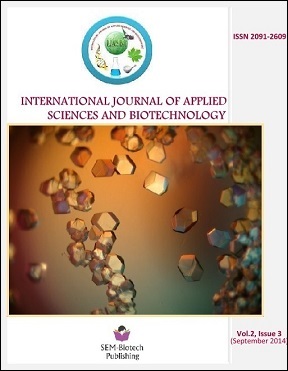Response of Tillage System, Nitrogen Level and Split Application of Nitrogen on Spring Maize in Chitwan, Nepal
DOI:
https://doi.org/10.3126/ijasbt.v2i3.11007Keywords:
Tillage, nitrogen rate, split application, grain yieldAbstract
Field experiment was conducted at Phulbari-9, Chitwan, Nepal during 2012 (Feb-July) to investigate response of tillage system, nitrogen level and split application of nitrogen on spring maize. The experiment was laid out in split-split plot design with twelve treatments and three replications, considering two tillage system (conventional and zero tillage) as main factor, three nitrogen levels (60, 120 and 180 kg N ha-1) as sub plots and spilt application of nitrogen (50 % each at basal and 45 DAS & 25% each at basal, 30, 45 and 60 DAS) as sub sub plot. Thousand grain weight, number kernel rows ear-1, number kernels ear-1, grain yield, stover yield and harvest index were significantly not influenced by tillage systems. Thousand grain weight, number of kernel rows ear-1, number kernels ear-1, grain yield, stover yield as well as harvest index showed remarkable increase with increasing N rate and number of N split application. Significantly, higher grain yield (8.91 t ha-1) was observed in 180 kg N ha-1 applied plot than the plots given 120 kg N ha-1 (8.15 t ha-1) and 60 kg N ha-1 (5.29 t ha-1). Four equal split application of nitrogen yielded significantly higher grain (7.68 t ha-1) than two equal split application of nitrogen (7.22 t ha-1). It is concluded that either conventional or zero tillage with application of 180 N kg ha-1 with four split application can increase yield and yield attributes.
DOI: http://dx.doi.org/10.3126/ijasbt.v2i3.11007
Int J Appl Sci Biotechnol, Vol. 2(3): 298-301




